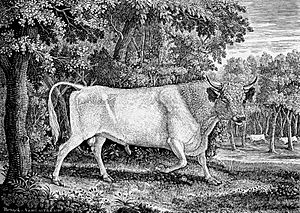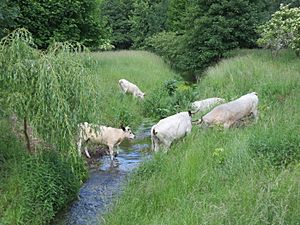White Park cattle facts for kids
The White Park is a special and rare breed of cattle with ancient roots, mostly found in Great Britain. These cows have unique horns. There are two similar groups of cattle, the Chillingham Wild Cattle in Northumbria and the Vaynol cattle from Gwynedd in North Wales. They are considered separate breeds. In the United States, there are not many White Park cattle. They are often called the Ancient White Park there to tell them apart from the American White Park, which is a different type of cow.
Contents
What Makes White Park Cattle Special?
The White Park is a medium-large cow with a long body. Adult bulls usually weigh between 800 and 1000 kilograms (1,760 to 2,200 pounds). Adult cows are typically 500 to 700 kilograms (1,100 to 1,540 pounds). They have a very clear look: their bodies are white, like porcelain, but their ears, noses, and sometimes their feet are colored black or red.
Their horns are also special. Cows' horns often curve gracefully upwards and forwards. Bulls have thicker, shorter horns. In Britain, these cattle are known for their unique look and for liking to graze on rough, wild land.
How White Park Cattle Live
White Park cattle are good at living in natural ways without a lot of help from people. Some herds stay outside all year, even in tough weather, on rough grazing land. They don't need special shelters or extra food. They are usually calm, have calves easily, and live a long time.
In the past, White Park cattle were used for three things: meat, milk, and pulling carts or plows. People used them for pulling things until about 1914. Some cows were still milked in 1951, but they didn't produce a lot of milk. Later, they became mainly known for their meat. Their beef is known for being tasty and having good marbling, which means it has fat mixed in that makes it flavorful. This meat is often sold in special markets.

Scientists have studied the DNA of White Park cattle. These studies show that they are genetically very different from other breeds. Their special white coat with colored points is also seen in other cattle breeds like the Irish Moiled and the Texas Longhorn. The breeds most similar to White Park cattle are the Highland cattle and Galloway cattle from Scotland. However, the White Park is still very unique compared to all other British breeds.
The History of White Park Cattle
About 2,000 years ago, cows similar to the White Park breed lived across much of Britain and Ireland. In ancient Ireland, there are stories about white cows with colored ears being important for ceremonies. This suggests that white cattle were either common or highly valued. White cattle were known in Ireland until the 1820s, but they died out there. Similar stories are found in Welsh history. Pembroke in western Wales was a main place for the breed until the 1800s.

In 1225, a law by King Henry III led to many parks being fenced off. Several herds of these white cattle, like those at Chartley and Chillingham in England, and Cadzow in Scotland, were put into these "emparked" areas. In the early 1800s, there were more than a dozen White Park herds in Britain. But by the early 1900s, most of these herds had disappeared.
Saving the Breed
A program to register White Park Cattle in Britain began in the early 1900s. However, by 1946, only a few herds remained as domesticated groups. The very old herds at Vaynol and Chillingham had become wild or semi-wild. The registration stopped during World War II.
Later, in 1973, the Rare Breeds Survival Trust was created in Britain. The next year, the registration program for White Park cattle started again. Since then, their numbers have grown. Now, there are more than 1,000 breeding cows in the UK.
White Park cattle have also been sent to other countries. In 1921, some went to Denmark, then to Latvia in 1935, and to Germany in 1972. In 1987, cattle were sent to Australia. In 1940, a few pairs of White Park cattle went to Canada. Their calves born in Canada were later moved to the Bronx Zoo and then to the King Ranch in Texas. In the USA, they are called Ancient White Park to avoid confusion with another breed.
Today, many countries test the DNA of their White Park cattle. This helps to check their family lines and make sure the breeding programs help the breed survive. The goal is to increase good traits while keeping the cattle genetically diverse. The total number of purebred White Park females around the world is now almost 2,000, plus bulls and young cattle.


